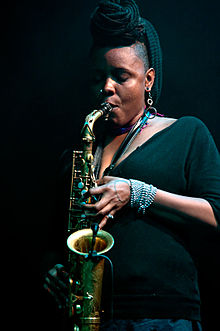Coin Coin Chapter Four: Memphis
| Coin Coin Chapter Four: Memphis | ||||
|---|---|---|---|---|
| Studio album by Matana Roberts | ||||
|
Publication |
||||
| Label (s) | Constellation | |||
|
Format (s) |
CD, LP |
|||
|
Title (number) |
13 |
|||
|
running time |
46:40 |
|||
| occupation |
|
|||
|
Studio (s) |
Breakglass Studios, Montréal |
|||
|
||||
Coin Coin Chapter Four: Memphis is a jazz album by Matana Roberts . The recordings were made in Breakglass Studios in Montréal and were released on October 18, 2019 on the Canadian label Constellation.
background
The first three Coin Coin albums by Matana Roberts, Gens de Couleurs Libres, Mississippi Moonchile and River Run Thee , published between 2011 and 2015, should present the history of the USA and its African American population from a different perspective, writes Martin Schray. Coin Coin was planned as a twelve-part large-scale work based on the life story of the former slave and later entrepreneur Marie Thérèse Coincoin, who lived in Louisiana at the turn of the 18th and 19th centuries and was the ancestor of Roberts. Roberts' parents moved to Chicago from the south of the USA and also used "Coincoin" as a nickname for their daughter. “The project is therefore also a personal search for one's own roots, but in terms of an alternative historiography it is much more. As a result, this album - like its predecessors - is field research, political intervention and sound event at the same time. "
As a concept artist in episode 4 of her long-term project, the musician deals with the south of the USA and her family roots and also remembers the grandmother pictured on the cover. For Coin Coin Chapter Four: Memphis , Roberts formed a new band with Hannah Marcus (guitars, violin, accordion), drummer Ryan Sawyer , Montréal bassist Nicolas Caloia and Sam Shalabi on guitar and oud, and trombonists Steve Swell and the Vibraphonist Ryan White as a guest musician. While Coin Coin Chapters One, Two, and Three approach women as platforms to explode outwardly in sound, Coin Coin Chapter Four: Memphis focuses more on the creation of myths through the transmission of the protagonist in a broadly narrative form.
In addition to the multidisciplinary aesthetics and narrative power that Roberts used on the previous Coin Coin albums, she also presented various compositional approaches - she calls this "Panorama Sound Quilting" - the music arrangements ranged from big band to sextet to solo. Their music was mostly as free jazz classified, but in reality it were more of a cacophonous soundtrack, which made a loud bouquet of brass, Ouds would, mouth harps, mouth organs, violins, guitars and vibraphone, Martin Schray wrote. So Memphis reminds you of Gens de Couleurs Libres ; As in the first part of the series, Roberts uses blues , Latin American music and gospel motifs, she even quotes jazz classics (here “ St. Louis Blues ” in “Fit to be Tied”). In the longest piece (the album consists of 13 tracks, but is more of a long suite), "Trail of the Smiling Sphinx", Roberts lays bluegrass fiddles, freely improvising wind instruments and dark rhythms, a fascinating jumble of styles that suggests that the blacks and whites in the south were clearly separated from each other ("the house of God, they say, was not a place for races to mix," the child remembers someone who says at the end of the route). In addition, Roberts uses various vocal and verbal techniques: folk song , recitation , cathartic screeching, operatic voice, low lullaby , choral music , call and response schemes - in general, the revival of various American folk traditions and spirituals.
The opening number "Jewels of the Sky: Inscription" sets the tone with deep, meditative chants and saxophone. "Trail of the Smiling Sphinx" contains excerpts from old folk songs, namely "Paddy on the Turnpike" and "Cold Frosty Morning". The melodies of popular American songs are given a modern identity; WC cell phones "St. Louis Blues ”is performed on“ Fit to Be Tied ”, but its interpretation sounds like a slow, sad fanfare. "Her Mighty Waters Run", a version of "Roll the Old Chariot Along", contains an arrangement with singers Thierry Amar, Nadia Moss and Jessica Moss. “How Bright They Shine” also contains an arrangement of Pee Wee King's “ Tennessee Waltz ”.
Track list

- Matana Roberts - Coin Coin Chapter Four: Memphis (Constellation - CST145)
- Jewels of the Sky: Inscription 1:48
- As Far As the Eye Can See 4:03
- Trail of the Smiling Sphinx 9:43
- Piddling 2:29
- Shoes of Gold 3:07
- Wild Fire Bare 5:41
- Fit To Be Tied [St. Louis Blues] (WC Handy) 2:41
- Her Mighty Waters Run 4:57
- All Things Beautiful 2:30
- In the Fold 3:16
- Raise Yourself Up 2:44
- Backbone Once More 0:51
- How Bright They Shine 2:50
reception
The first installment in Matana Roberts' coin coin series, Gens de Couleur Libres (2011), revealed her as an innovative and imposing force in contemporary jazz, wrote Jeff Tench (Treble). In it she dealt with the tragic history of slavery in the USA and at the same time delivered an intense fusion of jazz, spirituals and the spoken word. Chapter four of this series is one of the most challenging and fascinating at the same time, and revolves around a story that her grandmother told her about a woman whose parents were killed by the Ku Klux Klan . and as such, the material is sad, angry, intense and tormented. It's not necessarily Robert's most accessible work, “but it's beautiful in the midst of the chaos and affection for its protagonist, even in the context of a violent and hateful narrative. It is without question one of the most important jazz recordings of the year and will definitely leave an impression. "
Chris Barton ( Los Angeles Times ) also counts it among the ten best jazz albums of 2019. According to Chris Barton, Roberts is an artist who "is able to unleash a storm, whether on the saxophone or through the spoken word". Roberts' album is characterized by "a restless, holistic approach to musical storytelling that conjures up the nightmares of slavery in a way that is haunting, challenging and consistently captivating."
According to Olaf Maikopf ( jazz thing ), the former member of the Exploding Star Orchestra has had an excellent reputation as an innovative musician and conceptual artist , not just since “Chapter One” . Roberts did not design her homage to her grandmother in an old-fashioned conventional manner, but in an avant-garde, psychedelic manner. Although she combines her torrent of speech and her singing with strong echoes of early blues , African beats , gospel and Cajun , this search for the identity of the black community is really brought to life by the self-confident will not to surrender to any limit. According to the author, Matana Roberts' experimental sound installations are "timeless, sometimes crude atonal, then almost delicately folkloric and suddenly wildly unspoilt."
According to Mona Tavakoll (Pitchfork), Roberts is one of those artists "who are permanently disturbed by the wing of a single, broad muse - here is the muse America, boiled in her own blood, restlessness, courage and hatred." Her self-appointed task in a planned 12-part album suite, which can unsatisfactorily be described as free jazz (in reality, however, it is more of a historical fiction, accompanied by a loud bouquet of horns, oud and vibraphone) is with that of an essayist Elizabeth Hardwick comparable, which makes her protagonist say on the first page of her best, funniest and last work “Sleepless Nights” (1979): “This is what I have decided to do with my life,” she writes. "I will do this work of transformed and even warped memory and live this life." Like Hardwick, Roberts has a firm sense of purpose and a fabulous impulse that begins with a vision of the past - on this album memories of a young woman whose parents are killed by the clan, a story her Memphis- born grandmother told her - which she used as a detonator for a hailstorm of praise and shrapnel.
Martin Schray (Free Jazz Blog) wrote: “Surrounded by these excellent musicians, Roberts' Alt is in its most sublime place, at the same time integrated and dominant in their sounds. This arrangement makes your sound shine even more beautifully. In a nutshell: Coin Coin Chapter 4: Memphis is the next element of Roberts' contribution to 21st century liberation music, oscillating between meditative, evocative exploration, jazz tradition and free improvisation . Without a doubt my album of the year. "
Thom Jurek gave the album 4½ (out of 5) stars in Allmusic and wrote that Roberts explored “the creepy amalgamation of folklore and history that defines the way we present ourselves or reject ourselves when we are in the dark want to stay. ”Roberts questions official reports, slave narratives, her family's stories and her identity as an African American woman. She explores and explodes myths, historical, spiritual and cultural. Coin Coin is not one story, but many, an insightful exploration of blackness outside of the infamous twin filters of race and class that define America. Like its predecessors, Coin Coin Chapter Four: Memphis is n't and shouldn't be "easy" to listen to given the way it's researched and explained, Jurek said. “That is, it is a necessary, engaged art that is repeatedly listened to for its revelation to unfold and hopefully open a door to understanding. It is arguably the strongest and most convincing of the Coin Coin releases that have been published so far. "
Kevin Le Gendre wrote in the journal Jazzwise that counted the album of the best jazz albums of the year 2019, the remarkably wide tonal spectrum show the ecstatic rebound of a Jew's harp , rousing country blues -Fiddle- riffs , occasional, to Ornette Coleman reminiscent breakdowns and Instrumental interludes that are consistently imaginative, no more than an extremely haunting movement of vibraphone and percussion that sounds as if wind chimes are running backwards. For all moments of gripping abstraction, however, it is the heartbreaking a cappella interludes “Her Mighty Waters Run” (“Roll the Old Chariot”) and “This Little Light of Mine” that also prove to be enormously powerful. Robert's ability to treat such challenging, complex material with a clear focus is testament to the strength of her original vision and skill as a narrator. In less good hands (instead of with their core quintet) the music could appear slightly overblown, if not even diffuse; but Roberts has "retained her conceptual focus and creative power to deliver work that has structural inventions and a deep sharpness that should move anyone interested in real life."
Individual evidence
- ↑ a b c Martin Schray: Coin Coin Chapter Four: Memphis. Free Jazz Blog, October 6, 2019, accessed January 7, 2020 .
- ^ A b Coin Coin Chapter Four: Memphis. jazzthing, October 28, 2019, accessed January 7, 2020 .
- ↑ a b Mona Tavakoll: Matana Roberts: Coin Coin Chapter Four: Memphis. pitchfork, October 22, 2019, accessed on January 7, 2020 .
- ^ Matana Roberts - Coin Coin Chapter Four: Memphis. In: jazztrail.net. May 6, 2019, accessed on January 7, 2020 .
- ↑ Matana Roberts - Coin Coin Chapter Four: Memphis on Discogs
- ↑ Jeff Tench: The 10 Best Jazz Albums of 2019. Treble, January 1, 2019, accessed January 9, 2020 .
- ↑ a b Chris Barton: Best jazz albums of 2019: A year rife with invention and resistance. Los Angeles Times, May 6, 2019, accessed January 7, 2020 .
- ↑ Review of Thom Jurek's album at Allmusic (English). Accessed January 1, 2020.
- ↑ Kevin Le Gendre: Top 20 Jazz Albums of 2019. Jazzwise, November 21, 2019, accessed on January 7, 2020 .

